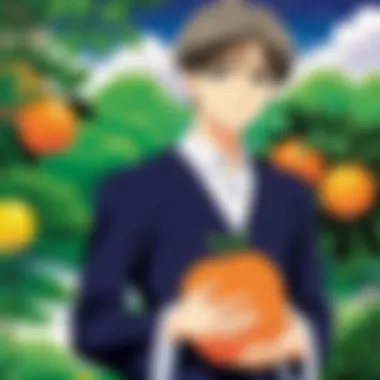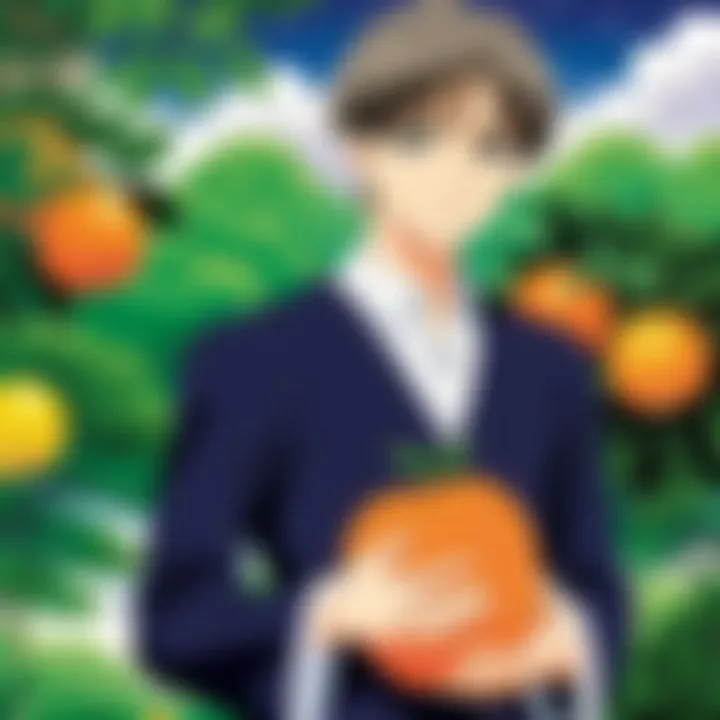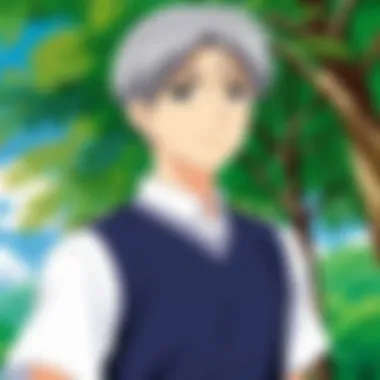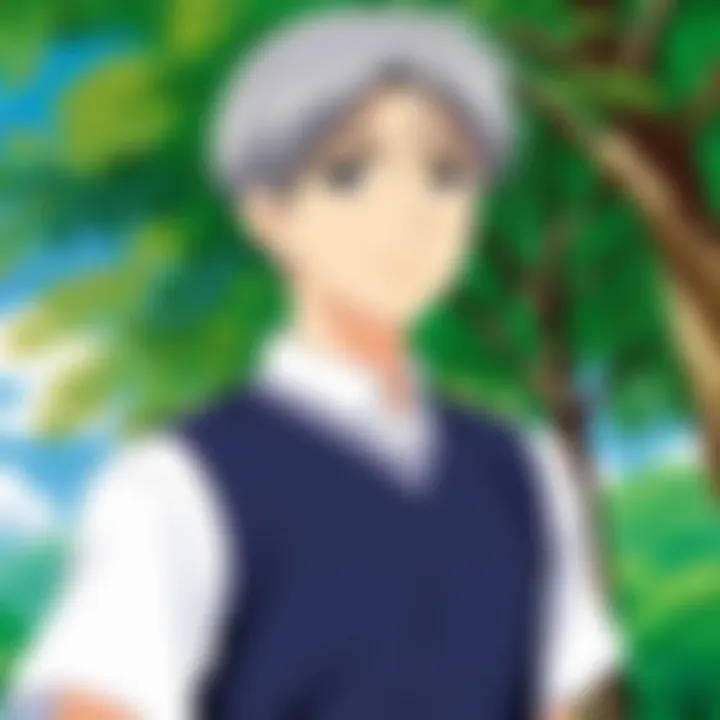Exploring Fruits Basket: A Detailed Guide to the Manga


Intro
Fruits Basket, a manga that has etched its name in the hearts of many, offers a rich tapestry of emotional experiences, intricate character arcs, and the kind of storytelling that invites deeper contemplation. Here, we will dive into the various layers that make this series resonate with fans and followers alike, particularly in its English edition. It’s more than just a narrative involving strange transformations; it’s a compelling exploration of trauma, love, and redemption.
From its humble beginnings as a serialized manga in 1998 to a beloved franchise adapted into anime, the journey of Fruits Basket deserves meticulous examination. Its significance extends beyond mere entertainment; it serves as a cultural bridge, bringing Japanese storytelling to a global audience, with its themes remarkably translatable to diverse cultures. Readers will find themselves delving into a world where every character carries a weight, every plot twist serves a purpose, and underlying themes of acceptance and familial bonds shine brightly.
Equipped with this understanding, the sections ahead will take readers through critical plot evaluations, character deep dives, and insights into the comparison between the manga and its animated form. We will also touch upon industry developments relevant to the ongoing life of Fruits Basket in popular culture.
Let’s begin by exploring the sequence of events through meticulous episode reviews.
Prologue to Fruits Basket
The world of Fruits Basket stands as a significant pillar in the manga landscape, merging heartfelt narratives with deeply resonant themes. This article aims to furnish readers not just with a curtain-raiser to this beloved series but also with a thorough exploration of its many facets. Using this guide, aficionados and novices alike can better appreciate the series’ rich tapestry.
Overview of the Series
Fruits Basket, originally serialized in Hana to Yume from 1998 to 2006, revolves around Tohru Honda, a high school girl who becomes entwined with the enigmatic Sohma family. Unbeknownst to her, the family is cursed to turn into animals of the Chinese zodiac when embraced by members of the opposite gender. That quirky yet poignant premise serves as a springboard for themes of acceptance, family ties, and personal transformation.
The series captures a slice of life filled with emotional depth. It deftly balances the whimsical and the serious, inviting both laughter and tears. The manga’s expansive character roster, ranging from the spirited Tohru to the troubled Yuki and the fiery Kyo, allows for a multitude of arcs enhanced by evolving relationships, bringing the cast to life in ways that avid readers would feel profoundly.
Fans often cite the intricate narrative structure as a major garner of attention. Each arc not only builds upon the last, providing a seamless continuity of events but also unveils deeper themes that resonate with struggles of self-identity and the burden of familial expectations. Through its pages, the artwork aids the narrative by visually enhancing emotional cues that simply words alone might not convey.
Author and Creation Process
Natsuki Takaya, the author behind Fruits Basket, played an integral role in the creation process. With her personal experiences and emotional landscape as the bedrock, Takaya infused elements which are both relatable and profound. Initially influenced by her personal struggles with relationships and acceptance, she weaved these intimate aspects into her characters, resulting in a palpable sincerity that permeates every interaction within the manga.
The artwork itself evolved over time; her early drafts showcased a more simplistic style, gradually maturing into a more refined and expressive form as the story progressed. Her dedication and understanding of the human condition lend Fruits Basket its lasting impression, making it not merely a story about characters but an exploration of the nuanced human heart.
“The beauty of Fruits Basket lies in its imperfections: it teaches us that love and acceptance can exist even in our flaws.”
From concept to completion, Takaya's commitment exemplifies how personal truths can shape a narrative that resonates across borders, cultures, and generations, ensuring that Fruits Basket remains a cherished classic in manga history.
Narrative Structure
The narrative structure of a story often serves as its backbone; it's how the tale unfolds and how the audience engages with the content. In the context of Fruits Basket, this structure is more than just a method for storytelling. It is a reflection of the characters' emotional journeys and their interactions, weaving in touches of fantastical elements with genuine human experiences. The arrangement of plot points, character developments, and thematic reiterations provides a rich tapestry that invites readers to lose themselves in the world Takaya Natsuki has created.
By examining the narrative structure, we glean insights into the pacing and rhythm of the story, understanding when to expect emotional highs and lows. This examination allows fans and newcomers alike to appreciate how the seemingly simple premise evolves into a profound commentary on life, acceptance, and the intricacies of human relationships. Thus, the structural framework plays a critical role—without it, the thematic explorations might fall flat.
Main Plot Points
At the heart of Fruits Basket lies a compelling story that is both simple and intricate. The main plot revolves around Tohru Honda, a high school student who, after the dramatic loss of her mother, finds herself homeless. Fate takes an unexpected turn when she stumbles upon the Sohma family, who harbor a secret that intertwines their lives with the Chinese Zodiac.
Here are some key elements that shape the narrative:
- Tohru's Introduction to the Sohmas: The moment Tohru meets Yuki, Kyo, and Shigure is pivotal. It sets the stage for the exploration of her feelings of acceptance and belonging.
- The Sohma Curse: A mystery unfolds as Tohru learns that the Sohma family is cursed to transform into animals of the Zodiac when hugged by the opposite sex. This introduces both comedic moments and deeper emotional conflicts.
- Character Revelations: Each character has a backstory that unfolds gradually, adding layers to the plot. These revelations give readers insight into why the characters behave as they do, enhancing the depth of the narrative.
- Confronting Trauma: As Tohru befriends the Sohmas, each character grapples with their own personal struggles, from familial expectations to emotional scars. This results in powerful moments of vulnerability that drive the story forward.
Overall, the main plot points—highlighting acceptance, love, and the journey of self-discovery—create a compelling narrative that showcases how individuals overcome personal demons and embrace connections with one another.
Character Arcs
Character arcs in Fruits Basket are not just a matter of development; they are a significant aspect of how the story resonates on a deeper level. Each character's journey is tied intricately to the central themes of the manga, especially concerning family ties and the quest for identity. The way characters evolve throughout the series adds nuance to the plot and reinforces the emotional stakes.
Take a look at some notable arcs:
- Tohru Honda: Tohru's growth is perhaps the most visible throughout the series. Initially portrayed as a cheerful and optimistic girl, she gradually learns about the complexities of life and relationships. Through her interactions with the Sohmas, Tohru confronts her grief and realizes the strength in vulnerability.
- Yuki Sohma: The Prince of the school, Yuki battles with his own demons, stemming from his upbringing and relationship with his family. His arc is one of finding confidence and acceptance, moving from isolation to connection.
- Kyo Sohma: Kyo’s development is raw and emotional. Struggling with his identity due to the expectations placed upon him by his family and the weight of his transformation curse, he learns to embrace himself and open up to others.
Ultimately, the arcs within Fruits Basket are more than just personal stories; they serve as mirrors reflecting the themes of trauma, love, and self-acceptance. Readers may see elements of their own life journeys in these characters, which fosters a sense of connection that transcends the typical boundaries of manga storytelling.
"The beauty of Fruits Basket lies not only in its story but in how it resonates with the heart, revealing the simplicities and complexities of our own existence."
Character Analysis
Delving into the world of Fruits Basket, we can’t brush aside the profound role of character analysis. It's not just about names and faces; it’s about the complex emotional landscapes these character inhabit. A thorough dissection of the characters unveils layers of narrative that are vital for understanding the overarching themes and development within the manga. By analyzing each character, readers gain insight into the motivations and conflicts that shape their actions. This understanding can lead to a richer reading experience, bringing to light nuances that one might otherwise miss.
Main Characters


The heartbeat of Fruits Basket undoubtedly lies within its main characters. Tohru Honda, the protagonist, embodies resilience mixed with innocence, navigating her life while caring for those around her. Her interactions with the cursed Sohma family highlight themes of empathy and unconditional love.
Yuki Sohma, often seen as the prince, is a character fraught with insecurities hiding behind a charming facade. He represents the struggle many face when trying to conform to societal expectations while yearning for personal freedom. Kyo Sohma, the fiery and passionate counterpart, provides a striking contrast; his volatile nature often reflects the chaos within himself, stemming from his family's curse. This trio not only elevates the narrative but engages readers to reflect on their own experiences and relationships.
Supporting Characters
In addition to the central figures, Fruits Basket is replete with supporting characters who enrich the story. Akito Sohma, the family head, personifies a conflicting blend of power and vulnerability, echoing the profound impact of parental relationships on mental health. The character of Hatori Sohma provides a stark reminder of the burdens carried by those who wish to protect others, often at the expense of their own happiness.
Moreover, minor characters like Hana and Uo add depth and diversity, representing friendship and loyalty, showcasing how every individual contributes to the intricate web of life. Each supporting character, regardless of screen time, is meticulously crafted to echo the struggles of the main cast, making the narrative far more compelling.
Character Relationships
The relationships among characters in Fruits Basket serve as a mirror reflecting the core themes of the narrative. Tohru’s bond with Yuki and Kyo illustrates how love can be expressed in myriad forms—friendship, romantic interests, or even familial love. The complexities of their triangular relationship invite readers to ponder the nature of affection and rivalry, often revealing more about themselves.
The dynamic between Akito and the other Sohmas is equally significant. It highlights themes of control, fear, and the yearning for acceptance. Akito's interactions transform from moments of cruelty to subtle hints of vulnerability, explaining the reasons behind their actions. This makes for a profound inquiry into how trauma shapes relationships.
"In the end, it’s not just about the characters themselves, but what they represent—hope, loneliness, acceptance, and so much more."
Through understanding these relationships, readers can glean valuable lessons about human emotions and interactions, making the journey through Fruits Basket much more than mere escapism.
The analysis of character in Fruits Basket does not merely serve as an exploration of fictional personas but becomes a reflective lens on one's own life experiences and relationships. Each character, in their own right, invites readers to confront their vulnerabilities and triumphs—a true testament to the depth of this beloved series.
Themes and Motifs
The narrative of Fruits Basket dives deeper than surface-level storytelling, intertwining complex themes and motifs that resonate profoundly with its audience. These elements not only enhance the plot but also add richness to character development and emotional engagement. Understanding these underlying messages is vital for anyone attempting to grasp the series' true essence.
Family and Relationships
When considering Fruits Basket, family is a cornerstone theme that emerges throughout the story. The series presents various families, each woven with unique struggles and dynamics. At the heart of it lies Tohru Honda, an orphan who finds herself enmeshed within the cursed Sohma family.
The exploration of family is not limited to blood relations. The portrayal of chosen family is equally important, emphasizing that connections are built upon trust and love, rather than merely genetic ties. For instance, Tohru’s relationship with her late mother serves as a guiding force, shaping her interactions with those around her. This motif illustrates how past relationships can serve as both a blessing and a burden, as characters grapple with expectations, loyalty, and emotional trauma.
"Family isn’t always blood. It’s the people who stand by you when you need them."
Additionally, familial relationships in Fruits Basket often confront harsh realities such as abuse, neglect, and acceptance, urging the audience to reflect on their own familial bonds. The intricacies of these relationships highlight the complexity of love and the pain that sometimes accompanies it. These nuances make the series relatable and poignant, offering a mirror to readers’ own experiences with family.
Transformation and Identity
Another notable theme is transformation, both literally and metaphorically. The characters of Fruits Basket are often seen undergoing significant changes that reflect their evolving identities. The physical transformations due to the zodiac curse serve as symbols for deeper emotional and psychological struggles. Each character's animal form represents their intrinsic fears, character flaws, or personal burdens.
For example, Yuki Sohma embodies the rat, always depicted as overshadowed by his brother’s brilliance, which manifests as a constant struggle with his self-worth. In facing these shadows, characters embark on journeys of self-discovery and acceptance, influencing their relationships and choices.
This theme underscores a vital message: identity is fluid. Characters evolve through trials and tribulations, suggesting that growth stems from embracing one’s true self rather than conforming to the expectations of others. The series encourages readers to consider their own identities and the transformations they might undergo throughout their lives.
Coping with Trauma
The complexities of trauma permeate the fabric of Fruits Basket. Each character has their own past experiences, etched with pain, loneliness, or heartache. The series deftly illustrates how individuals cope with trauma in various ways, from avoidance to confrontation.
Tohru Honda embodies resilience, using her innate positivity to shield herself from the darkness of her past. Her journey serves as a beacon of hope, demonstrating the importance of support systems in overcoming personal struggles. Conversely, some characters resort to denial or destructive behaviors as a means of coping, such as Akito Sohma’s controlling nature, which stems from a turbulent upbringing.
The exposure of these varied methods encourages readers to engage with the content on a profound level. It showcases the importance of addressing emotionally challenging subjects while recognizing that healing is not linear. The portrayal of trauma in Fruits Basket not only serves as a catalyst for character development but also invites readers to examine their own experiences and responses to adversity.
In summary, the themes of family, transformation, and coping with trauma in Fruits Basket contribute significantly to the overall narrative. They not only enrich character arcs but also resonate intimately with readers, making Fruits Basket a compelling examination of the human experience.
Cultural Impact
The cultural impact of Fruits Basket is a multifaceted subject that touches various aspects of the anime and manga landscape. Understanding its significance helps readers grasp not only the story's value but also its contributions to broader narratives in pop culture. While the series offers entertainment, it also serves as a cultural touchstone, influencing countless fans and creators alike. This discussion highlights specific elements and benefits that showcase the series' prominence.
Fruits Basket in Anime Culture
Fruits Basket occupies a special place in anime culture, representing a blend of heartfelt storytelling and unique character dynamics. It is credited with popularizing the shoujo genre, especially in the West, where it resonated with readers looking for depth in both plot and characters. The combination of supernatural elements and emotional themes allowed the show to appeal not just to young girls, but also to a wider audience.
Key elements of its cultural significance include:
- Character Development: The growth of characters like Tohru Honda and the members of the Sohma family resonated with viewers, teaching them about acceptance and resilience.
- Gender Representation: The series dives into complex gender roles and relationships, providing varied representations that challenge stereotypes.
- Emotional Themes: It artfully tackles issues such as trauma, loss, and familial bonds, allowing viewers to see reflections of their own lives within the narrative.


The 2001 anime adaptation further catapulted its arrival in pop culture but also set the stage for the 2019 revival, which not only updated the animation quality but sought to adhere closer to the original manga’s storyline. As the series evolved, so did its relevance, showing its ability to adapt to changing cultural landscapes.
Reception and Critique
The reception of Fruits Basket spans a broad spectrum, filled with accolades and criticisms alike. Upon its initial release, it garnered praise for its intricate character dynamics and emotional depth, but not all feedback was glowing.
Many fans laud the series for its ability to tackle complex themes and present relatable characters. Some strengths noted include:
- Emotional Resonance: Readers have often cited their emotional connections to the characters as a high point, citing that Tohru's warmth and compassion serve as a beacon of hope.
- Relatable Storylines: The struggles with family trauma found in the series allow it to resonate well beyond its genre, opening conversations about mental health and self-acceptance.
However, critiques do exist. Some argue that certain aspects of the plot may feel slow-paced or meander through side stories, deviating from the main thread. Some nuances of the story could be lost in translation or misrepresented in adaptation, leading to disappointment among fans seeking a faithful rendering of the manga.
"Fruits Basket beautifully combines the fantasy elements of manga with relatable human experiences, making it a timeless piece."
Publication History
The publication history of Fruits Basket is key to understanding its impact and continued relevance in anime and manga culture. This section sheds light on the series' origins, its journey across language barriers, and the various editions that fans have cherished over the years. Examining how Fruits Basket was published allows us to appreciate the craftsmanship behind the manga, as well as the challenges faced by translators who sought to convey the manga's charm and depth to a wider audience.
Original Japanese Edition
The Fruits Basket manga was first published in Japan by Tokyopop, hitting the shelves in 1998 and continuing until 2006. Written and illustrated by Natsuki Takaya, it originally appeared in Hana to Yume, a shoujo manga magazine. The series quickly gained traction, resonating with readers through its engaging narrative and relatable themes. By tapping into the complexities of adolescence and familial ties, it carved a niche that was both unique and accessible.
While the art and storyline are paramount, the publication's pacing also played a significant role in the manga's success. The layout of panels, the choice of dialogues, and the overall aesthetics were crafted with meticulous attention, staying true to Takaya's vision while allowing the story to breathe. Moreover, the original series included not just the main story but also additional chapters known as "Hana to Yume Specials." These provided further depth to the characters, offering readers a glimpse into their lives beyond the primary narrative.
English Translations
The first English edition of Fruits Basket rolled out by Tokyopop in 2004. Many fans were eager to delve into this heartfelt story, yet the journey from Japanese to English was not without its wrinkles. Translators faced the daunting task of maintaining the essence, humor, and cultural nuances that are often lost in translation. Misinterpretations can alter the entire tone and mood of specific moments, but the team behind the English adaptation did commendable work to preserve the story's spirit.
In addition, the translations also had to accommodate cultural references, some of which might not be familiar to Western readers. Finding equivalent expressions or explanations without steering too far from the original’s charm posed an interesting challenge. Given its popularity, Fruits Basket has seen multiple versions of translations over the years, including digital formats and collections.
Collector's Editions
Over the years, Fruits Basket has been celebrated with various collector’s editions, aiming to both honor longtime fans and attract new readership. One noteworthy example is the Fruits Basket Collector's Edition first published in 2019, which includes brand new covers, enhanced artwork, and deluxe binding. Such editions provide a fresh take while navigating nostalgia, enticing avid readers to revisit the series or enticing new readers with their high-quality aesthetic.
In addition to these editions, merchandise surrounding Fruits Basket has flourished. Items such as the high-quality artbooks, posters, and figurines have further solidified its place in fan communities around the world, especially for those keen on showcasing their love for this iconic series.
"No matter how many editions or translations surface, the heart of Fruits Basket continues to resonate, reminding fans of its undeniable emotional depth and relatability."
In summary, the publication history of Fruits Basket reveals the meticulous process of bringing a beloved story to audiences both in Japan and abroad. Understanding this journey illuminates the greater narrative and cultural significance of the series in the landscape of manga. Its success can be partly attributed to the thoughtful consideration given to every phase of publication, from the original creation to the modern-day collectors hoping to capture a piece of its legacy.
Influence on Subsequent Works
The impact of Fruits Basket on the manga industry is both profound and multi-faceted. It hasn't just shaped its own genre but has also laid the groundwork for countless works that followed. The series’ unique blend of comedy, drama, and romance thrust open the doors for creators to explore more complex character dynamics and intricate storytelling. In a way, it’s not too much to say that Fruits Basket redefined expectations for what a shoujo manga could deliver.
Influence on Manga Artists
Fruits Basket stands out as a beacon of inspiration for a whole generation of manga artists. For instance, you can clearly see its echo in works like Yona of the Dawn by Mizuho Kusanagi, where the themes of transformation and personal growth resonate deeply. Similarly, in Anohana: The Flower We Saw That Day, emotional exploration is a central theme, showcasing the ongoing influence of Natsuki Takaya’s ability to weave serious themes into relatable narratives.
New manga creators openly acknowledge the groundbreaking nature of Fruits Basket. Many cite its portrayal of vulnerable characters navigating difficult life situations as something that inspired them to push the boundaries in their own work. The innovative approach of using a curse as a plot device to explore deeper emotional states set a precedent that can still be felt today. It’s no stretch to say that many artists learned, adapted, and improved upon the foundations laid out by this beloved series.
Legacy within the Genre
The legacy of Fruits Basket within the shoujo genre is not something that can easily be overlooked. It stands amongst titans, having opened pathways for titles that followed. The series taught future creators the importance of character-driven plots, blending fantastical elements with the mundane. It pushed the envelope on what sort of emotional stories could be told in manga, helping to cultivate a genre where readers could expect rich character development alongside whimsical storytelling.
Another key element of its legacy is the balance it strikes between humor and emotional weight. Many modern manga and anime productions attempt to walk this tightrope, demonstrating how laughter can coexist with heartache. Creators like Ai Yazawa, known for Nana, continue to reference Fruits Basket in their works, often incorporating nuanced characters and emotional complexity into their narratives.
"Fruits Basket showed us that in every smile, there’s a story, and in every tear, a connection. Its legacy is the emotional landscape it painted for future works."
Furthermore, Fruits Basket has had an enduring impact on the themes tackled in later series. Issues of trauma, identity, and the importance of family that were first presented in Fruits Basket can now be found in many contemporary shoujo works. Readers today have Fruits Basket to thank for paving the way for deeper explorations of what it means to be human in all one’s complexities.
In summary, the influence of Fruits Basket on subsequent works is tangible and impressively widespread. The manga serves not only as a cornerstone of the shoujo genre but also as a wellspring of inspiration for artists and writers who continue to navigate the intricate dance between humor and sorrow in their storytelling.
Adaptations Outside Manga
The world of Fruits Basket extends far beyond its pages, capturing hearts through various adaptations that further illustrate its themes and characters. This section highlights two primary adaptations from the manga - anime interpretations and stage productions. These forms not only amplify the narrative’s reach but also introduce it to broader audiences, evolving its impact in popular culture.


Anime Adaptations
The anime adaptations of Fruits Basket play a crucial role in expanding its fanbase and enhancing the story's dimensions. The first anime, which aired in 2001, covered only a part of the manga, diverging in some aspects. Even so, it set the stage for the franchise’s popularity in the West, exposing many to the story of Tohru Honda and the cursed Sohma family.
However, the 2019 reboot is where things truly began to flourish. This adaptation faithfully follows Natsuki Takaya's original manga, diving deeper into character backstories and emotional nuances. Viewers were treated to a cast that brought vibrancy and depth to the already rich narrative.
"The 2019 anime rebirth of Fruits Basket feels like a warm hug, wrapping nostalgia and freshness in one single package."
A few key aspects of the anime that deserve attention include:
- Visuals and Animation: The modern adaptation boasts improved animation quality, with backgrounds and character designs that maintain the delicate art style of the manga, captivating the audience visually.
- Voice Acting: The choice of voice actors resonates with fans, breathing life into characters and allowing viewers to feel a deeper emotional connection.
- Soundtrack: Music in both adaptations captures the tone of the narrative brilliantly, heightening pivotal moments and enhancing the viewer's experience.
For many fans, the anime serves as an accessible entry point into Fruits Basket, inviting newcomers to explore the intricacies of the original manga.
Stage Productions
Fruits Basket has also made a notable leap into the realm of theater, with various stage adaptations showcasing its story through live performances. These productions add a unique flavor to the narrative, allowing audiences to experience the emotional beats in real-time.
The stage performances typically focus on key story arcs, enabling viewers to engage with the characters in a dynamic way. One striking feature of these adaptations is the integration of music and dance, elements often absent in traditional storytelling methods. They create a different atmosphere, transforming Fruits Basket from a visual and textual experience into an auditory and physical one.
Important considerations of stage adaptations include:
- Audience Interaction: The live setting allows for a sense of connection, with actors often interacting with the audience, making them feel as if they are part of the story.
- Interpretations: Every performance can offer a different interpretation, providing new insights into character relationships and themes.
- Cultural Representation: Stage adaptations highlight cultural nuances, showcasing elaborate costumes and settings that immerse the audience in the rich tradition that Fruits Basket embodies.
The adaptations outside the manga form a broader understanding of the tale, showing that its themes of love, trauma, and redemption are profoundly resonant across diverse platforms. Whether through the lens of animation or the energy of live theater, the essence of Fruits Basket remains, still pulling at heartstrings.
Fruits Basket Merchandise
The presence of Fruits Basket merchandise reflects the series’ cultural impact and its continued relevance among fans. For many, collecting items related to their favorite manga is more than just a hobby; it’s a way to express their love for the story and its characters. Fans find solace in tangible products that connect them back to the world of Fruits Basket. This section explores the various types of merchandise available, emphasizing the uniqueness and appeal they hold.
Collectibles and Figures
When it comes to Fruits Basket collectibles, one specific category stands out: figures. These meticulously crafted figures, often depicting beloved characters such as Tohru Honda or Yuki Sohma, provide a physical representation of the anime magic. Not only do they adorn shelves, but they often inspire conversations among enthusiasts.
Fans appreciate how figures capture the essence and emotion of each character. Many of these collectibles are produced by companies like Good Smile Company, known for their quality and attention to detail.
Additionally, there are limited-edition figures that create buzz among collectors. The thrill of hunting for these unique items can be akin to embarking on a treasure hunt. Many collectors enjoy showcasing their finds on social media platforms, joining a larger community of Fruits Basket fans.
Another notable collectible is the various art books released, which often include interviews, concept art, and behind-the-scenes insights. These books serve as treasures, arming fans with deeper knowledge about the characters and their development. Owning such a book isn't just a pleasure but also a badge of honor among one's peer group.
Clothing and Accessories
Apparel has become another way fans of Fruits Basket can express their admiration. Clothing items such as t-shirts, hoodies, and caps featuring illustrations or quotes from the series are popular choices. They allow fans to wear their passion on their sleeves—literally.
Not to mention, accessories play a huge role too. Keychains, pins, and even phone cases adorned with characters or symbols from the series add a subtle flair to daily life. Each item becomes a conversation starter, a connection to others who appreciate the nuances of the series.
The community also values handmade items, such as those found on platforms like Etsy. Independent creators often craft unique merchandise that can't be found anywhere else. This DIY aspect of collecting acknowledges both the creativity of artisans and the open-mindedness of the fandom.
In summary, Fruits Basket merchandise goes far beyond mere products. They encapsulate the experiences, feelings, and connections that come from the story. Collecting these items builds a bridge between fans, inviting them into a larger conversation about themes of love, identity, and belonging.
"Merchandise can serve as a gateway to deeper understanding of a series and its cultural significance."
In the end, navigating the landscape of Fruits Basket merchandise is an enriching experience, lending depth to the relationship fans have with the series, making it a cherished part of their lives.
Final Thoughts on Fruits Basket
As we draw near the conclusion of this comprehensive exploration of Fruits Basket, it becomes clear that this series is more than just a story about cursed zodiac members and their transformation into animals. It embodies intricate character dynamics, profound themes, and a unique artistic vision that resonates across cultures. This manga has left an indelible mark on the landscape of anime and manga, warranting thoughtful reflection on its enduring legacy.
Epilogue on Its Legacy
Fruits Basket stands as a hallmark in the realm of shoujo manga, bridging the gap between fantastical elements and relatable human experiences. The delicate weaving of various themes, such as identity, family bonds, and trauma, creates a narrative that is heart-wrenching yet uplifting. It pushes readers not only to sympathize with the characters but also to reflect on their own lives and relationships.
"A story that encourages acceptance, healing, and understanding is timeless. In this light, Fruits Basket rises to the occasion beautifully."
Moreover, the layered storytelling and charming artwork contribute enormously to its popularity; characters are vividly rendered, allowing readers to form emotional attachments that linger long after the last page is turned. Each arc within the manga elucidates significant life lessons, which have prompted extensive discussions within fan communities. To put it plainly, its legacy is cemented not merely through sales numbers but by its capacity to foster connection and dialogue among its audience.
Recommendations for New Readers
For those stepping into the vibrant world of Fruits Basket for the first time, there are several considerations to keep in mind that will enhance the experience:
- Start with the original manga: While the anime adaptations are splendid, they cannot provide the same depth and nuances found in the manga. The emotions, character thoughts, and slight details crucial for understanding relationships shine through on the pages.
- Take your time: Rushing through the volumes can lead to missing the subtleties embedded in Yuki's social struggles or Tohru's resilience. Each chapter adds layers to character development and thematic richness.
- Engage with the community: Several forums and platforms, such as reddit.com and Facebook fan pages, are bustling with Fruits Basket enthusiasts. Discussing chapters and theories with fellow fans can provide deeper insights and different interpretations.
- Explore supplementary materials: Many editions include author notes and behind-the-scenes artwork that can enrich your understanding of the characters and the story's production.
By diving into Fruits Basket, readers are not just enjoying a tale of cursed destinies; they embark on a journey through emotional landscapes that challenge and inspire. Each reader will undoubtedly discover a piece of themselves within the lives of the Sohma family.







